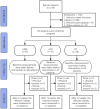Effects of 12 weeks of Head-Down Strong Abdominal Breathing Training on Gait and Cognitive Function in Patients with Chronic Obstructive Pulmonary Disease
- PMID: 40330797
- PMCID: PMC12051985
- DOI: 10.2147/COPD.S514766
Effects of 12 weeks of Head-Down Strong Abdominal Breathing Training on Gait and Cognitive Function in Patients with Chronic Obstructive Pulmonary Disease
Abstract
Background: As chronic obstructive pulmonary disease (COPD) progresses, it can limit physical activity, resulting in reduced mobility. And patients with COPD have a higher incidence of cognitive impairment compared to normal individuals. The aim of this study was to investigate the effect of breathing training in COPD patients' gait and cognitive function by changing the body position.
Study design and methods: Eighty-three COPD patients were recruited and randomized (1:1:1) into a head-down strong abdominal breathing training group (HDBT), a head-down training group (HDT), and a strong abdominal breathing training group (BT). Cognitive function and gait performance were assessed after the intervention by comparing patients' stride frequency, stride length, step speed and Montreal cognitive assessment(MoCA) scores.
Results: 63 patients completed this study. After 12 weeks, in terms of Obstacle walking tasks gait, the HDBT group significantly improved the performance of COPD patients in obstacle walking tasks in terms of stride length (73.29±0.64, P<0.001), step speed (97.73±0.47, P=0.018) performance. At the same time, we also found that there was no statistical difference in the gait performance of each group in the walking task (P > 0.05). In terms of cognition, cognitive function scores(MoCA) were significantly higher in HDBT (P<0.001) HDT (P<0.001), and BT (P<0.001) compared to baseline.
Conclusion: A 12-week HDBT program elevated cognitive function and improved stride length and speed metrics during an obstacle walking task in patients with stable COPD.
Clinical trial registration number: chictr2400080452(30/01/2024).
Keywords: chronic obstructive pulmonary disease; diaphragm; dual-tasking; gait analysis; head-down position; pulmonary rehabilitation.
Plain language summary
Why was this study done? People with chronic obstructive pulmonary disease (COPD) often face challenges with movement and thinking skills as their condition worsens. Everyday tasks like walking around obstacles can become harder, and memory or focus may decline. This study tested whether simple breathing exercises—with or without body position changes—could improve walking ability and cognitive health in people with stable COPD. What did the researchers do? Researchers divided 63 adults with COPD into three groups for 12 weeks: Group 1 practiced breathing techniques while lying head-down. Group 2 did head-down positioning without breathing exercises. Group 3 did breathing exercises in normal sitting/standing positions. They measured changes in walking patterns (step length, speed) during regular and obstacle-filled paths, along with cognitive tests. What did they find? The head-down breathing group showed clearer improvements in stepping over obstacles compared to other groups. All groups scored better on cognitive tests after 12 weeks. Simple walking (without obstacles) showed no meaningful changes across groups. What do these results mean? Combining breathing practice with position changes may help people with COPD move more confidently in challenging situations like avoiding tripping hazards. The cognitive improvements across all groups suggest breathing exercises alone—whether lying down or upright—could support brain health in COPD. While longer studies are needed, these non-drug approaches show potential for helping people stay active and mentally sharp. Patients and healthcare teams might consider adding similar exercises to daily routines.
© 2025 Song et al.
Conflict of interest statement
The authors declare that the study was conducted in the absence of any business or financial relationship that could be interpreted as a potential conflict of interest.
Figures
Similar articles
-
Effect of 12-week head-down strong abdominal breathing on cognitive function in patients with stable chronic obstructive pulmonary disease: a single-centre randomised controlled trial protocol.Trials. 2024 May 30;25(1):351. doi: 10.1186/s13063-024-08193-8. Trials. 2024. PMID: 38816733 Free PMC article.
-
Effects of 12 weeks of head-down strong abdominal breathing on motor and cognitive performance during dual-tasking in patients with chronic obstructive pulmonary disease: Study protocol for a randomised controlled trial.Heliyon. 2024 Jul 8;10(14):e34255. doi: 10.1016/j.heliyon.2024.e34255. eCollection 2024 Jul 30. Heliyon. 2024. PMID: 39100443 Free PMC article.
-
Dual-task performance and balance in patients with severe COPD: a cross-sectional study.Ther Adv Respir Dis. 2024 Jan-Dec;18:17534666241287302. doi: 10.1177/17534666241287302. Ther Adv Respir Dis. 2024. PMID: 39655871 Free PMC article.
-
Active mind-body movement therapies as an adjunct to or in comparison with pulmonary rehabilitation for people with chronic obstructive pulmonary disease.Cochrane Database Syst Rev. 2018 Oct 10;10(10):CD012290. doi: 10.1002/14651858.CD012290.pub2. Cochrane Database Syst Rev. 2018. PMID: 30306545 Free PMC article.
-
Tailored or adapted interventions for adults with chronic obstructive pulmonary disease and at least one other long-term condition: a mixed methods review.Cochrane Database Syst Rev. 2021 Jul 26;7(7):CD013384. doi: 10.1002/14651858.CD013384.pub2. Cochrane Database Syst Rev. 2021. PMID: 34309831 Free PMC article.
References
Publication types
MeSH terms
LinkOut - more resources
Full Text Sources
Medical
Research Materials



